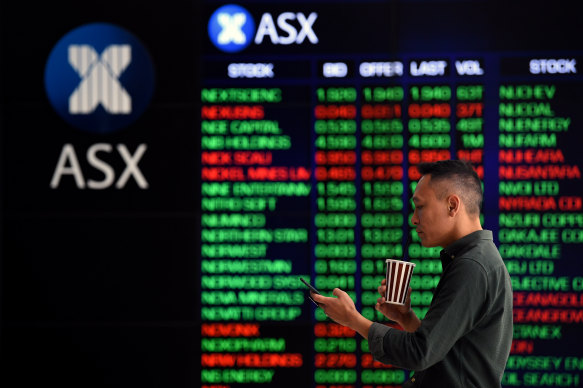By Lucy Battersby and David Scutt
The local sharemarket swung in a huge range on Monday, as it dropped 193.7 points during a morning slump then gained momentum from Asian markets to close only 49.7 points lower. By the end of the day, futures markets were pointing to gains on Wall Street and commodity prices were re-bounding on expectations central banks will cut rates to stimulate economic growth.
The S&P/ASX 200 closed 0.8 per cent lower at 6391.5 points. It has now fallen 11.2 per cent, or 805 points, from the record high struck on February 20. The index has fallen for seven sessions in a row, its longest losing streak since September 2018.

A rebound on Chinese markets helped spur a recovery on the local bourse on Monday, as gold and oil prices also made back ground.Credit: AAP
Despite Monday afternoon's improved outlook, there remains a lot of uncertainty with COVID-19 cases increasing around the world.
"As things stand, it is hard to see a path to convincingly good news on the coronavirus front in the weeks ahead. The virus now has such global momentum that things seem certain to get worse before they get better and they might get very much worse," wrote Paul O’Connor, head of Janus Henderson Investors' multi-asset team, in a note released on Monday.
"Central banks are undoubtedly going to start cutting rates very soon. Still, they do not have much ammunition at their disposal as the virus is a real economy shock that will not be easily solved by monetary means."
Financial markets remain fully priced for the Reserve Bank of Australia to cut Australia's cash rate to 0.5 per cent on Tuesday. An additional cut is also priced in for the middle of the year, which would take the cash rate to an unprecedented low of 0.25 per cent. The RBA has previously said that once the cash rate hits 0.25 per cent, it would likely introduce quantitative easing to support economic activity if required.
The financials sector underperformed the rest of the market on Monday, with a decline of 1.5 per cent compared to the boarder market fall of 0.77 per cent. Bank profit margins are likely to come under pressure if the target cash rate is reduced further. Westpac touched $22.68 on Monday, the lowest price for the bank's stock since July 2012. Materials also underperformed, with a decline of 0.9 per cent, as BHP fell to a 13-month low of $31.88 before closing at $33.35.
The energy sector was the best performer, gaining 1.1 per cent on the back of rises in Woodside Petroleum, up 1.5 per cent to $28.33, Santos, up 2.9 per cent to $7.03, and Viva Energy, up 5.4 per cent to $1.86. While consumer staples and information technology also closed higher, mostly thanks to WiseTech's gain of nearly 13 per cent to a closing price of $17.02.

Westpac shares fell to $22.68 on Monday, the lowest price in seven years as markets expect profit margins will come under pressure if the RBA cuts rates below 0.75 per cent. Credit: Will Willitts